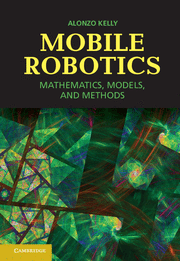Mobile Robotics: Mathematics Models and Methods
| This
book was originally written to record the content for my graduate
course in mobile robots - taught at the Robotics Institute since the
1990s. It is intended to be useful for both teaching and for engineers
who want a solid grounding in the fundamental topics of the field. Some
of the
mathematics may be beyond undergraduate level, depending on your
background, but motivated readers with an undergraduate exposure to
STEM disciplines should be able to master the contents. The
book makes no attempt to survey all of the relevant literature or to
inform researchers on latest developments and I could not possibly
reference every paper that is relevant or even significant for each
topic. The book is intended to capture at
least some of what is durably fundamental about the theory and practice
of mobile robotics.
The Publisher website for the book is www.cambridge.org/9781107031159 . There you will be able to preview its contents.You can buy the book online (paper or ebook) at Amazon here: http://www.amazon.com/Mobile-Robotics-Mathematics-Models-Methods/dp/110703115X |
|
